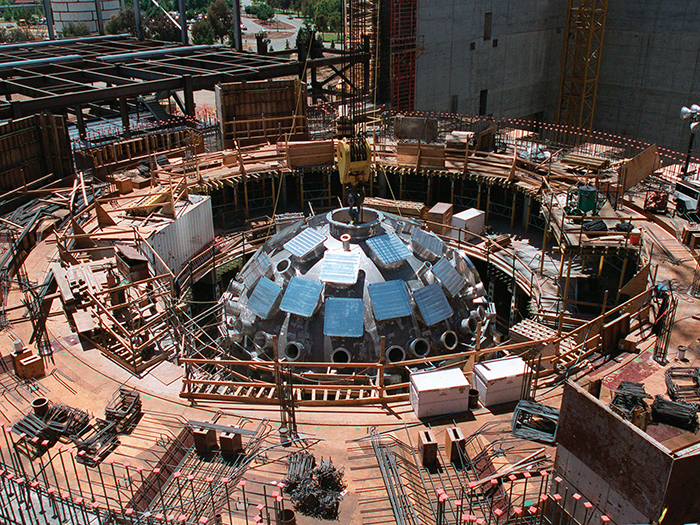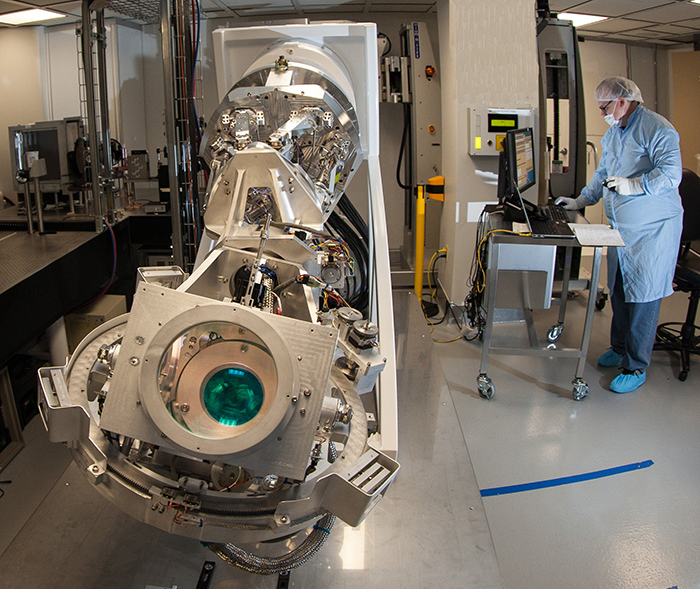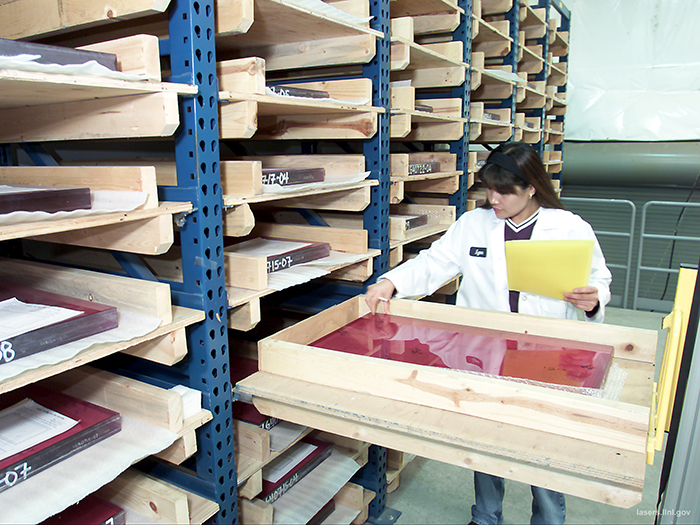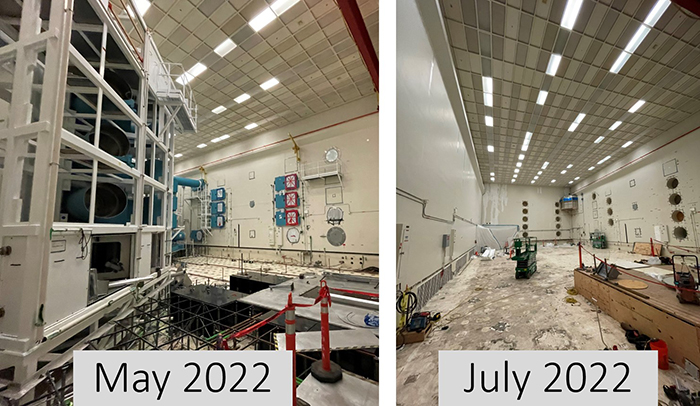NIF Sustainment:
Ensuring the Next 20 Years of Progress
May 10, 2023
Part 9 of “The Age of Ignition,” a NIF & Photon Science News Special Report describing the elements of Lawrence Livermore National Laboratory’s fusion breakthrough at the National Ignition Facility
Having blazed the path to fusion ignition at NIF, LLNL researchers and their collaborators are now making plans for sustained, and even higher, nuclear yields to enable and expand applications for stockpile stewardship and basic science research.

Achieving these goals will require sustained high availability of NIF, which was designed and built beginning in the mid-1990s. Much of the facility is more than 20 years old and many critical support facilities are in buildings approaching 40 years of age.
“NIF is a marvel of engineering, but it’s an aging marvel,” said NIF Director Gordon Brunton.
Since experiments began in 2009, NIF has been exceptionally productive and reliable. It has an experiment success rate of over 95 percent and fewer than 30 days of unplanned downtime in more than 2,400 days of shot operations.
“With more than 20 years invested in getting NIF where it is today,” Brunton said, “we must prioritize restoring the workforce and facility to sustainably continue to maximize the recent outstanding results. Building on a sustained NIF, our plans for further upgrades will extend our worldwide leadership in high energy density physics and keep NIF as a flagship scientific capability of the nation for decades to come.”
 Parts of NIF and its support facilities are decades old, including the 10-meter-diameter Target Chamber, shown being lowered into place in 1999.
Parts of NIF and its support facilities are decades old, including the 10-meter-diameter Target Chamber, shown being lowered into place in 1999.
Deferred maintenance, obsolescence, and aging issues are pushing NIF beyond its designed operating point, which is beginning to affect performance and increasing the risks of a significant stoppage or slowdown in experimental operations. As the premier tool of the science-based Stockpile Stewardship Program (SSP) for performing experiments in the high energy density (HED) regime, this outcome would have unacceptable consequences.
To assure that NIF continues to deliver for the SSP through its design lifetime of 2040, LLNL developed a five-year Sustainment Plan that identified urgent refurbishments, recapitalization, and improvements that must be addressed to sustain NIF.
“We identified 30 key refurbishment and recapitalization activities,” said Jeff Horner, NIF & Photon Science chief engineer and project manager for NIF Sustainment. “Work in some areas, mostly in planning, procurement, and hiring staff is already underway. We will replace obsolete components and do some equipment hardening to tolerate the more extreme radiation environment (in high-energy-yield shots).
“Among the improvements will be simplifying the removal and replacement of components for high-yield shots to restore lost efficiency. We are in a new regime of high-yield shots that these sensitive components were not designed for,” he said.
The first year, already underway, is focused on shovel-ready procurements and adding the necessary additional staff required to execute on the project scope. The second year, in fiscal year 2024, will consist mostly of planning and designing the large-scale projects. For the last three years of the plan, anticipated from fiscal years 2025 to 2027, all sustainment activities will be executed and completed.
 One planned sustainment activity will refurbish the Final Optics Damage Inspection (FODI) system to make it more radiation-tolerant and robust and to enhance performance. FODI, a complex, precision opto-mechanical telescope that examines optics between shots, can inspect optics up to 7 meters away and detect damage sites as small as 10 microns in diameter. With obsolete cameras and motion-control components and limited spares, FODI remains an ongoing single-point failure in NIF operations, resulting in more than 200 hours of delays annually. Credit: James Pryatel.
One planned sustainment activity will refurbish the Final Optics Damage Inspection (FODI) system to make it more radiation-tolerant and robust and to enhance performance. FODI, a complex, precision opto-mechanical telescope that examines optics between shots, can inspect optics up to 7 meters away and detect damage sites as small as 10 microns in diameter. With obsolete cameras and motion-control components and limited spares, FODI remains an ongoing single-point failure in NIF operations, resulting in more than 200 hours of delays annually. Credit: James Pryatel. To make this possible, there will be more dedicated maintenance time on NIF. Currently, NIF experiments are conducted five days a week, with two days devoted to maintenance and facility reconfigurations for the next week of experiments. Three times a year, longer maintenance periods are held, typically lasting two weeks.
“Maintenance of NIF has been an ongoing priority since the NIF became operational” said Brianna Arth, a deputy project manager for NIF Sustainment. “But now after 14 years of full operation, the facility has reached the age that major maintenance and refurbishment is needed.”
During the execution phase, additional facility maintenance time will be necessary for Sustainment Project activities that range from swapping optics to upgrading the complex control and data system. The team is currently developing plans for how much time will be necessary and to minimize the overall impact on the experimental data rate that NIF provides.
“It’s a real shift in mindset,” Arth said. “For so many years, we’ve been focused on the shot schedule and maximizing experimental time. Now we need to find a balance that addresses the current needs of the facility. It’s about setting ourselves up for success in the future, to continue doing higher- and higher-yield shots.”
Amplifier Refurbishment
 NIF’s original laser glass, shown here in 2005, has not been touched since it was installed. A recycling loop for the laser glass slabs used in the amplifiers is being created to refurbish this important component.
NIF’s original laser glass, shown here in 2005, has not been touched since it was installed. A recycling loop for the laser glass slabs used in the amplifiers is being created to refurbish this important component. One of the biggest and most urgent projects on the sustainment list is amplifier refurbishment. As the world’s largest optical instrument, debris is a perpetual problem for NIF. Debris can lead to increased light scatter and laser-induced damage, limiting optics lifetimes.
Of particular concern are NIF’s main laser amplifiers, which serve as NIF’s engine, delivering the very high infrared, or 1ω, laser energy required for every shot. The main amplifiers multiply the energy of the small seed pulse that starts each experiment to an energy in the range of the 10,000 to 20,000 joules needed to convert the beams’ 1ω light to 3ω (ultraviolet, or UV) light that ultimately drives the NIF targets.
“The amplifiers are essentially untouched since they were installed on NIF 15 to 21 years ago,” said Harpreet Juneja, amplifier refurbishment project manager.
Each time the NIF lasers fire, flashlamps in the beamlines are energized, emitting light that is absorbed by the amplifier glass. After 4,000 shots and counting, sealant on the amplifier blast shields, which separate the amplifier slabs from the flashlamps, has begun to degrade and is depositing debris on the amplifier optics. If left unchecked, this could cause permanent damage to these unique optics.
“Elimination of the debris must be addressed in the near term to avoid the possibility of having to reduce the operating point of the NIF,” Juneja said. “We’re going to remove, refurbish, and replace each of the laser glass slabs. We have extra slabs in inventory, but no way to procure more of these glass slabs. So, we will be creating a recycling loop.”
In addition, the blast shields will be removed and replaced. This entails purchasing raw material for the blast shields and coating them using an in-house technique. Work is underway on a new cleanroom facility for processing the blast shields and cleaning the amplifier glass slabs.
 The switchyard for the NOVA laser, a precursor to NIF, is being transformed into a processing facility for laser glass slabs.
The switchyard for the NOVA laser, a precursor to NIF, is being transformed into a processing facility for laser glass slabs. This is no small undertaking in a facility with 192 beamlines. Approximately 772 laser glass slabs and 1,728 blast shields need to be removed for refurbishment or replacement. Staff will work its way through the bundles of eight beamlines each over a multi-year period.
“One challenge is the volume of work. We need all hands on deck to do the removal and replacement or refurbishment,” Juneja said. “Another is that much of the equipment and vendors that we used to build NIF simply doesn’t exist anymore.”
For example, the order of installing the amplifiers on NIF doesn’t work as well for removing amplifiers. One project underway is to redesign and streamline the automated system that swaps line replacement units containing the amplifier blast shields.
New Engineering Opportunities
Sustainment will also provide new opportunities for the engineering staff to shift from operations to design. The overall project will take an estimated 50 to 70 additional staff members. About half will be new hires and about half will be redeployed from existing projects.
“This is as much about staff sustainment as it is about NIF sustainment,” Horner said. “I’m excited for our newer generation of engineers to have this opportunity to design and execute. I was the design engineer for the integrated optics module and had the opportunity to work on a lot of this equipment during NIF construction, and now it is their turn to deploy new and revitalized equipment.”
Completion of the NIF sustainment scope over the next five years will ensure NIF can continue to operate at its current performance through the 2030s.
“NIF sustainment will lay the foundations, for both the facility and our staff, on which we plan to further extend the performance of the laser over the next decade, and push to even high nuclear yields, opening up new relevant physics and fundamental science regimes,” Brunton said. “The future is bright—literally!”
Next Up: “High Performance Computing, AI, and Cognitive Simulation Helped LLNL Conquer Fusion Ignition”
More Information:
“The Age of Ignition: A NIF & Photon Science News Special Report”
—Patricia Koning
Follow us on Twitter: @lasers_llnl



